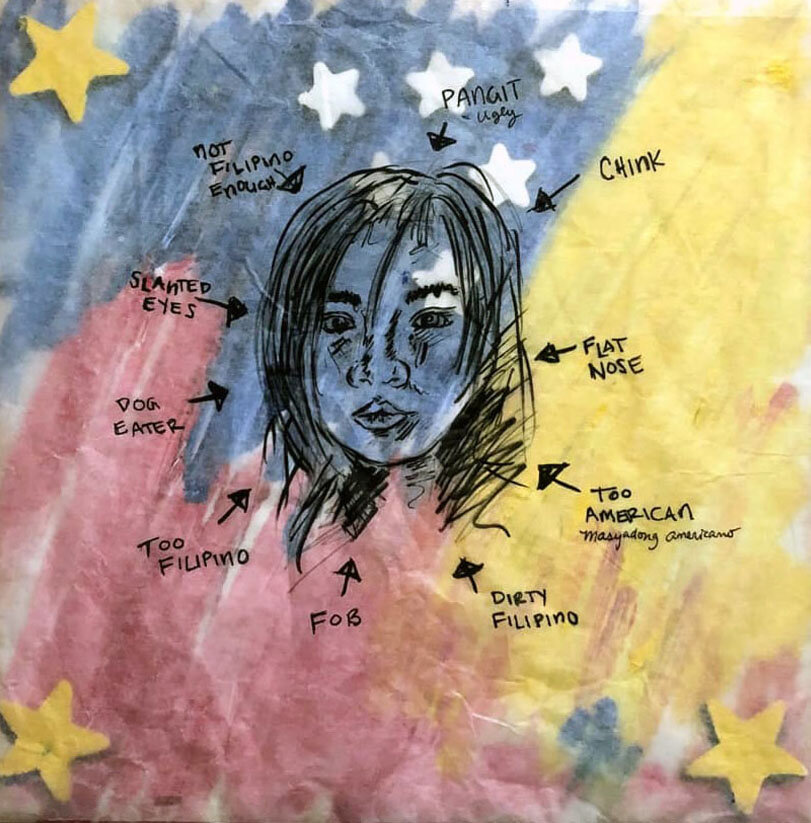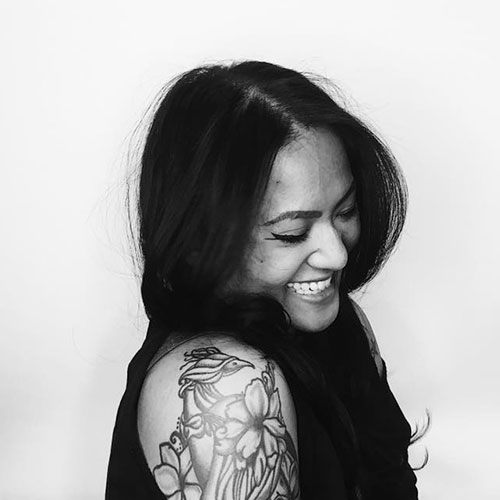In this Featured Member series, AATA celebrates the work of our members. During the coronavirus pandemic, we are inviting members to share their experiences about how their professional and personal lives have changed.
January 13, 2021
What has changed in your studies during the COVID-19 global crisis?
Because school is now virtual, how I remain disciplined at home has changed so I can stay on top of readings and project deadlines. I’ve recreated my space at home to be much more motivating and have implemented certain routines to remain focused on schoolwork. Outside of school, my clinical practicum allowed me to do telehealth with patients. It has been a learning curve to facilitate art-making over the phone, but I am learning a lot more, and the challenge has taught me a lot about how I speak to a client and pay attention to certain qualities and tones of my patient’s voice. I’ve had to learn how to engage with them even though I cannot see them in person. I have also had to become much more diligent in handling art supplies and setting up group art therapy sessions for my in-person sessions at the hospital. Working in this setting has stricter protocols for COVID-19 when it comes to PPE, and it has taught me to be more mindful of how my actions, even outside of the hospital, may impact my patients.
In what ways have your clients been impacted by COVID-19? How are you managing your own stress related to their experiences?
One of my patients I do telehealth with has a lot of anxiety about COVID-19 and restricts themselves from leaving their home and keeps to the stay-at-home order. Because of this, their level of loneliness has skyrocketed, and they sought out a connection with someone to stay well. I have been fortunate to be working with them since August 2020, and we have been working on their fears when it comes to COVID-19 and on their journey towards becoming a much more confident individual when it comes to making their own life choices. To better serve this patient, I make sure to journal or create art after the session to reflect on any feelings. I have also committed to a 5-minutes breathing exercise before and after the session to stay grounded and focused.
Since the killing of George Floyd, the topic of race has once again been brought to the forefront of national dialogue. How have race related issues, social justice, and racism informed or impacted your work as an art therapist or studies as a student?
As a woman of color student, race has also been at the forefront of my mind and life. Although it is disheartening to see that it took another black man’s life for others to see how much of a more significant issue this is, hearing and seeing advocates and community organizers do their best to bring justice gives me hope. As a student, I am continuously questioning the books I read, films we’re assigned and make it a point to bring up questions that may be sometimes uncomfortable to talk about in class.
Unfortunately, a lot of the work I’ve been reading still lacks research and support for other cultures, specifically Filipino cultures, and does not include an even wider cultural lens of treating this population. I’ve become even more aware of the systemic racial injustice found not only in our government but sometimes also in academia. I’ve pushed myself to remain open-minded, curious, and continue to question everything I read, hear, or see because I want to gain a broader range of perspectives and worldviews. This allows me to take into account that not everything I read in school is necessarily the correct information. As a future art therapist and counselor, this is a reminder to myself how important it is to understand the patient/client’s perspective and see the world from their lens to better inform how we treat them. We have to consider the issue they are bringing to us at the table and look at the systems they are a part of, if any of those systems bring any forms of oppression or stress, and be mindful of how privileged we may be.
In what ways has your living or work space changed?
I am considered an “essential worker” in my role as a Registered Behavior Technician. Because I am providing in-home services to families and their children on the autism spectrum, I wear PPE and am mindful of my actions outside of my job. This is the same in the hospital setting I am interning at, ensuring the scrubs I wear are washed separately from other clothes and set for all my gear. Because I am living with family, the extra precautions I take include routines of disinfecting myself when I arrive home. I also used to travel a lot; however, due to travel restrictions and my patients/clients/family’s safety, this is something I’ve put a pause on. Travel is a big part of my identity. At first, I struggled with it, but being raised in a strong collectivistic household has helped me understand community importance and the need to protect those within.
How do you view your role as an art therapy student during COVID-19?
As an art therapy student during COVID-19, I believe this is a time to advocate the power of expressive arts therapy. We have an opportunity to change the narrative that treatment isn’t only talking to a person about your problems, but is a door to be creative, imaginative, and escape from any pain or stress a person may be going through. There are numerous emotions COVID-19 has brought up, which can easily overwhelm anybody, including myself.
As art therapy/counseling students, we can use this opportunity to share the knowledge with others on how to regulate our emotions better and use the arts to help us express them. A technique I have been doing since starting graduate school has helped me prioritize my roles while being in school and working during a pandemic. Like the Wellness Wheel introduced at Adler University, I consider all the different “hats” I wear (examples: student, daughter, dancer) and list them out. Using a pie chart, I divide up the circle to reflect on how much of my identity/time is used under that specific role (example: since I’m in school full-time, being a student may be a larger piece of that circle and giving me less time to be a dancer). By having this as a visual, I can see where I may be lacking or where I need to withdraw from for the sake of my mental health.
Is there anything else you would like to share?
Just a note to other graduate students in the field, there is so much more work to be done, especially to be socially responsible practitioners! So keep doing the research, asking the hard questions, and find an area of the field/population that may need us to advocate more for them!

“Never Good Enough” by Elisha-Rio P. Apilado. Mixed Media (ink, acrylic) on wooden canvas. 2019.
I am a Filipino-American and the only one among my siblings born in the States. It was challenging to comprehend which culture to embrace fully. The more I tried to be American, the more I was ridiculed. But the more I tried to be Filipino, the more I was yelled at for not being a “true Filipino” because I didn’t speak Tagalog fluently. This series features reflections on my mental well-being influenced by years of bullying, discrimination, and my self-esteem getting knocked down. I’ve seen first hand how being vulnerable about our mental health issues, especially within minority groups, has helped others better embrace themselves and recognize they’re not alone – so I hope this resonates with you. “
Never Good Enough” is dedicated to all those who have been affected by discrimination and unfairness to the point where it has caused a shift in their mental health. After reading through E.J.R. David’s book, Brown Skin, White Minds, I was appalled by how mental health is unimportant in Filipino communities. According to the research on the mental and behavioral health implications on Filipino-Americans, they have the highest rates in suicidal ideation and have a higher rate for self-esteem issues, substance abuse, incarceration, and schizophrenia (David, 2013, p. 145). This layered mixed media painting depicts how much my identity has been shattered by racial slurs and never feeling good enough to be neither American nor Filipino.
Elisha-Rio P. Apilado, BFA, RBT
 Before switching careers, Elisha-Rio worked ten years in marketing as an art director and graphic designer. After a couple of years working as an art teacher at homeless shelters and leading community art projects, she recognized the power of what art could do for an individual’s mental well-being. And that’s when she found art therapy.
Before switching careers, Elisha-Rio worked ten years in marketing as an art director and graphic designer. After a couple of years working as an art teacher at homeless shelters and leading community art projects, she recognized the power of what art could do for an individual’s mental well-being. And that’s when she found art therapy.
Elisha-Rio currently attends Adler University in Chicago to earn her Master of Arts in Counseling. She will then continue to become a Licensed Professional Counselor and obtain a Registered Art Therapist certification. As an active advocate of mental health and the benefits of expressive art therapies, Elisha-Rio has spoken at several Ignite Talk Chicago events about reframing mental health stigmas, and she has hosted several art-focused self-care workshops with the American Institute of Graphic Arts and Creative Women’s Co. She recently joined the Asian Mental Health Collective to open up the Chicago Chapter to provide roundtable discussions concerning mental health stigmas within the Asian community. When she’s not working as a medical art therapy intern with cancer and stroke patients at AMITA Health or providing ABA therapy as a registered behavior technician, she is busily training at the dance studio.
